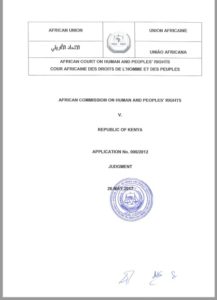
On 26 May 2017 the African Court finally rendered judgement in the case of African Commission on Human and Peoples’ Rights v. Kenya (Judgement). As background, this case involves a claim by the Ogiek people, an indigenous group who have called the Mau Forest in Kenya home for time immemorial. In October 2009 the Kenyan government served an eviction notice on the Ogiek people, requiring them to leave the Mau Forest within 30 days. Represented by the Ogiek Peoples’ Development Program (OPDP) and Minority Rights Group, the Ogiek people brought a case before the African Commission, arguing that this eviction, and Kenya’s treatment of them for decades, was in violation of various African Charter rights. I have written about the case before here, and conducted an in-depth roundtable in December 2016 with Lucy Claridge, Head of Legal at Minority Rights Group and Daniel Kobei from OPDP which you can find here. I am delighted to say that we are going to do a follow-up roundtable with Lucy and Daniel in the coming weeks which delves into the judgement even further. With this in mind, I am going to sidestep some of the indigenous issues in this post which are extremely important but perhaps are best dealt with by Lucy and Daniel. Instead, this post focuses on five other points for a little analysis.
1.This Judgement is a Landmark
There can be little doubt that this judgement will go down as one of the African Court’s landmark cases. It’s the first case to consider indigenous rights and sets out clearly that Kenya’s treatment of the Ogiek violated Articles 1, 2, 8, 14, 17 (2), 17 (3), 21 and 22 of the African Charter. This Judgement will not only have a considerable bearing on Kenya’s treatment of the Ogiek people but also on indigenous rights across Africa. But also consider the tone the African Court adopts. Throughout the Judgement, Kenya makes pretty much the same arguments; that Kenya is equal as evidenced by the Kenyan Constitution that says there is no discrimination against anyone including the Ogiek, that the Ogiek people no longer need the Mau Forest and even that the Ogiek are damaging the Mau Forest. But over and over the African Court dismissed these arguments. Reading the Judgement as a whole, I get the sense that the African Court has no time for Kenya’s ‘equality for all’ arguments. It seems, to me at least, that member states need to work a little harder to convince the African Court on these type of submissions, perhaps best summarised as “how can there be discrimination/violations when our Constitution/Laws state there is none?” in future cases.
2. The Judgement Draws Widely from International Law
Read the Judgement and you see the African Court consider the African Commission’s working group on Indigenous rights and the UN Special Rapporteur on Minorities in determining the criteria for the definition of ‘indigenous’. The African Court also looks at UN General Assembly declarations, the UN Declaration on the Rights of Indigenous Peoples, the Cultural Charter for Africa, and General Comments from the UN Committee on Economic, Social and Cultural Rights. Taking this all in, the reader is struck by the level of international law and procedure relied on by the African Court. This goes to show that whilst the African Court is limited to considering violations of only those international human rights instruments ratified by a member state subject to an application, it will not limit itself to these same instruments in considering a case and making findings on the merits. Applicants and their representatives should take note, and not limit the law relied upon to that ratified by the member state in their petition but look to all international law and procedure in building their case.
3. More Questions than Answers on Commission-to-Court Transfers?
An area which continues to intrigue me is the possibility of Commission-to-Court transfers. The potential is obvious; if you can persuade the African Commission to transfer cases to the African Court as it is entitled to under Article 3(1)(a) of the Protocol, the field increases from the current eight AU member states who have signed the Article 34(6) Additional Declaration to the 30 that have signed up to the African Court Protocol. Whilst Rule 118 of the Commission’s Rules set out the basic structure under which transfers may take place, there is little in the way of concrete discussion or criteria set out by either the African Court or African Commission as to how this is applied.
There was some hope that this Judgement, only the second transfer from the African Commission to African Court (African Commission v Libya being the other) might go into some detail on how these transfer issues are decided by the African Commission and/or African Court. Sadly, although perhaps not unexpectedly, the African Court doesn’t go into any great detail in the Judgement on transfer. As I have written previously, reading between the lines it seems fairly clear that having been burned in the Endorois case, the African Commission was keen to transfer the case, especially when Kenya ignored the African Commission’s order in this case for provisional measures, reminiscent of Kenya’s stance in the Endorois case before.
But leaving aside the process by which the transfer occurred, this Judgement does give us a fascinating window into what happens once a case is transferred. It is clear that the African Court considered the African Commission as the applicant in the case, not the NGOs who brought the case, or the Ogiek themselves. Read this Judgement alongside the African Commission’s statement on the case which seems to confirm that PALU acted as lawyers for the African Commission, and we seem to have at least four different groups under the “applicant” heading: (i) the African Commission; (ii) PALU as the African Commission’s lawyers; (iii) MRG and OPDP as the NGOs; (iv) the Ogiek people themselves. This seems like a lot of people to be acting under the same umbrella of “applicant”. It would be fascinating to know how the African Commission actually worked on the case; did they brief PALU on strategy? Did they take witness statements from the Ogiek? Was strategy formed as to how to bring the case? On this last point, presumably something must have been done in the way of strategy, and if so then the African Commission has, at least in this case, moved away from independent arbitrator of human rights allegations and instead became a litigator. If this is indeed the case, then how does it approach the next indigenous rights case filed before it back in its everyday guise as a human rights commission deciding cases? Is there a conflict of interest then between the African Commission considering future indigenous rights cases and its role as litigant in this case? I can see some merit in the argument that the African Commission is able to separate the two roles out, both in terms of personnel and in its role as an independent commission, but it seems a little strange to one moment be litigating and then the next sitting as independent commission on similar issues. Is it that the Commission would be safest to simply transfer cases and leave the litigation before the African Court to the original complainants?
4. A Helping Hand for Exhaustion of Local Remedies?
The Judgement also adds some interesting new detail to the age-old issue of exhaustion of local remedies. As followers of the African Court will know, member states almost always object to the admissibility of a case based on an applicants’ failure to exhaust local remedies. Member states usually argue that there is at least one more domestic venue, be it a court, commission or other, that the applicants should have tried before bringing a case before the African Court.
In the Judgement the African Court looks at three familiar matters: (i) the primacy of domestic courts; (ii) the “available, effective and unduly prolonged” test and; (iii) domestic remedies must be judicial in nature. But then the African Court does something else which seems to be new. It states that when considering the exhaustion of local remedies, what is important is that the matter or issue has been brought before domestic courts, not necessarily the same applicant. This is very interesting. It is not in doubt that the Ogiek people have been bringing legal cases for decades in an attempt to enforce their rights. What is not necessarily the case is that these particular NGOs and individuals have brought these cases. This situation did not seem to phase the African Court who set out that since the matter had been litigated before domestic courts, the applicants in this case had exhausted local remedies. If applied in the future this approach has the potential to increase the number of applicants who can bring cases before the African Court, as it seems to suggest that applicants can bring cases involving ongoing human rights violations who have not necessarily brought domestic cases themselves. For example, local remedies could be exhausted where an applicant takes up the baton from others within a community to challenge continued to ongoing violations at the African Court where others have been litigating in the past at the domestic level.
5. Amicable Settlement is a Real Thing
Finally, the Judgement mentions that the possibility of an amicable settlement was floated at one stage- a first for the African Court (at least as contained in a written judgement). This scenario moves the amicable settlement provision found at Article 9 of the African Court Protocol and Rule 57 of the African Court Rules away from being just a aspirational goal considered by some destined to be never used, to a real tool to try and bring a case to a conclusion without the need for lengthy litigation. Interestingly, it appears that the African Court itself initiated an attempt to find a settlement in this case after the public hearing. Given the nature of these type of negotiations are typically confidential, we may never find out what exactly was proposed and rejected, but it should be seen as positive that there were at least attempts, and it is something to look out for in future African Court Judgements.
